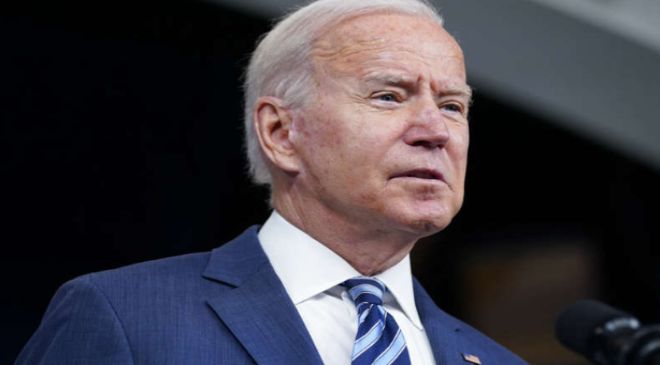Though we’re still more than a year out from the 2024 presidential election, the season for Democratic “bedwetting” has come early this cycle. Leading the apparent panic this month are a series of polls and accompanying analysis showing something that’s been pretty obvious for some time: Joe Biden is a really unpopular president — and that dissatisfaction will make a 2024 showdown with a Republican opponent pretty competitive.
Read More : Google bans Andrew Tate’s ‘The Real World’ App
Those recent surveys, from CNN and the Wall Street Journal, have shown Biden and his likely Republican opponent, former president Donald Trump, essentially tied or with a narrow Trump lead. Polling averages reflect the same dynamic. None of it should be surprising — though Democrats have openly or anonymously been torn about just how much to be worried by these polls. Some longtime Democratic operatives have dismissed the fears from insiders and donors: Former Obama campaign manager Jim Messina, for example, has been quick to tell fellow Democrats to relax and “just take a step back,” while others have argued that it’s too early, or attacked the polls themselves.
But there is value in looking at the polls because they reveal something else: At this point in the campaign, it’s unarguable that Democrats, especially Biden, are facing a problem with voters of color. And that weaker standing with Black and Latino voters specifically seems to be fueling those tight national polling numbers.
Read More : Your daily horoscope for Sept. 15 according to ChatGPT
That lower level of support for Biden is distinct from previous election cycles. The New York Times’ Nate Cohn, who has been tracking this for some time, analyzed last year and this year’s New York Times/Siena polls of over 1,500 nonwhite respondents. He reports that Biden leads Trump 53 percent to 28 percent among registered nonwhite voters — a sharp drop off from the 70 percent support Biden garnered from voters of color in the 2020 election. Those numbers aren’t exclusive to the Times, either, but show up across surveys. That’s a much worse position than a Democratic candidate has been in for the last few election cycles.
Whether this is a new problem or not is debatable (as I’ve written before, some Democratic operatives don’t want to concede they have a real problem with nonwhite voters). The causes for this weaker level of support are also up for debate: Some, like the liberal researcher and writer Ruy Teixeira, argue that progressive cultural politics are largely to blame, while other Democratic operatives argue this is a problem with messaging). But the trends in polls over the last year are all pointing at something, even if people disagree on the specific numbers at the margins.
Read More : 1 Nasdaq Stock to Buy Hand Over Fist Before It Triples in 5 Years
So, to understand these trends, I’ve assembled a few theories, informed by conversations with pollsters, strategists, and Democratic party operatives, for why this polling gap continues. Though there is some disagreement, some of it is due to Biden specifically, to the state of the economy, to differences among voters, and perceptions of the Democratic party. Here are three ways to view Biden’s nonwhite voter problem.
1. It’s just too early
No one I spoke with denied that there is something going on with Biden and Black and Latino voters — though it’s taken some time to admit it.
“We can’t bury our head in the sand and give excuses about why the polling is wrong,” Chuck Rocha, the Democratic Latino consultant who has frequently been critical of his party’s work with voters of color, told me. “Times have changed and if we continue to rely on these constituencies to vote at such a high number, I’m afraid Democrats will be disappointed unless we put in the work needed to get them there.”
The go-to explanation among the Democratic establishment, including the Biden campaign and the Democratic National Committee, is that it’s just too early — that most Americans, including voters of color across the country, aren’t tuned into the political process at this point in the year and aren’t yet aware of what the Biden administration has accomplished. They argue that is partially because the reelection campaign, though underway, hasn’t ramped up yet. And they say that they still have a lot of time to ramp up their outreach.
There’s a lot of truth to that feeling: Coming off of the summer season, political news does not tend to be the priority for most Americans, and Biden’s major accomplishments — the Inflation Reduction Act, the Bipartisan Infrastructure Act, the investments in manufacturing and technology in the CHIPS Act — may not seem to be affecting the lives of the average American.
Read More : Five essential items for the frequent traveler
“There hasn’t been the same kind of linkage between the legislation that Biden has helped pass, his overall agenda, and getting credit for it,” Daniel Cox, a pollster and the director of the American Enterprise Institute’s Survey Center on American Life, told me. “[Voters ask], ‘Okay, he did this thing, it passed. Do I see any evidence in my own community or my own neighborhood? Are any of these things having any impact in my life?’ I think for a lot of voters, the answer is no.”
Campaign and party operatives acknowledge this fact — but time and messaging alone don’t explain what the polling is showing.
2. “Voters of color” aren’t monolithic — and have complicated feelings about the Democrats
The term “nonwhite” voter itself hides a lot of complexity — and “Democrat” itself is only partially helpful. Support among Black Americans for Biden, for example, is much higher than among Hispanic or Latino voters. Latino voters tend to be younger than Black voters. Democrats seem to face bigger hurdles to retaining support from Black and Latino men, compared with women, while Biden specifically is underperforming with lower-income voters of color.
Read More : New COVID shots: Five things to know after CDC’s approval
Bad feelings about the economy are still the single largest issue affecting Biden’s standing with all voters, including voters of color. Though the state of the economy is objectively improving (there’s no recession in sight, inflation is improving, and unemployment remains low), those material conditions take longer to improve when you’re on the lower end of the economic spectrum.
“This is very similar to 2012 — Barack Obama had the same issues with the economy and dissatisfaction with the economic recovery. But just like then, we have to tell a story, and keep talking about our solutions,” Kristian Ramos, a Democratic Latino consultant, told me. “We have work to do. We have the time to do it. And everything that I’ve seen, when people hear about what we’ve done, they like it. It moves these undecided voters to our side.”
The youth of the average Black or Latino voter also complicates the picture: younger voters tend to be dissatisfied with Biden, but that does not mean they are switching sides to vote for Republicans en masse. Cox argues that distinguishing between Biden and the Democratic Party is important to understand this dynamic: While younger voters of color might not want to say they’re Biden supporters at this point, they still have an affinity for the Democratic Party and its identity as the more progressive force in national politics.
“If you look at the Democratic Party among young people, it tends to be more positive than views of Biden. So it’s possible that Biden has artificially deflated support just because of who he is: his age, his background, his approach to politics, him being an old-school politician in a party that has increasingly become more progressive and wants more dynamism in their leaders,” Cox said. And that dissatisfaction also shows up in polling about Biden’s accomplishments: older voters are more willing to give Biden credit than younger voters.
Some of that gap can be explained by the different ways younger people consume political information, Rocha told me. “There’s lots of reasons. There’s more than three TV channels. There’s social media. Younger Black and Latino folks are acting much differently than their mothers and fathers,” Rocha said. “That just means there’s going to be more work needed —most of these campaigns are running broadcast TV commercials, because that’s where older people that are the regular voters are consuming information and you’re not reaching these younger Black and brown voters because they’re consuming all their information on mobile devices and streaming devices.”
And there’s a cultural divide: voters of color tend to be a bit more conservative on social issues than the white college-educated voters that have been growing more Democratic in the Trump era, as reflected in the varied opinions by Black and Latino voters on abortion, immigration, gender identity, and crime. As Cox’s AEI colleague Texeira has written before, those more moderate leanings don’t mean nonwhite voters are running to the GOP, but it does suggest that Democrats have more work to do to overcome the feeling among some nonwhite voters that they are not represented in the Democratic Party’s more progressive identity.
3. Black and Latino voters tend to be neglected
Across most of the conversations I had with party insiders one thing was clear: Biden’s campaign and the Democratic apparatus supporting him are off to a good start. They’ve made the right hires of Black and Latino staffers to guide efforts with voters of color, they’ve made huge early investments in advertising to Black and Latino voters in battleground states, launched outreach efforts specifically targeted at Black and Latino men, and hosted engagement events in Mississippi, Florida, Wisconsin, and Kentucky. The next few months will be crucial in seeing whether this engagement begins to pay off, and whether this softer support for Biden bottoms out.
“If you’re asking me about Joe Biden, the first thing I’d say is, well, you need a person of color leading the campaign. Check. Did you start really early? Well, they started early, whether it’s the DNC or the campaign or Building Back Together (a Democratic-aligned outside group),” Rocha told me. “We need to admit that there’s an erosion in these constituencies, but that we have plenty of time to get it back to close where it needs to be.”
Read More:-The 3 Most Undervalued Dow Stocks to Buy in September 2023
Antjuan Seawright, a Democratic strategist working with the DNC to support Biden and reach Black voters, echoed this explanation, and noted that it’s encouraging to see early investment from the Biden campaign and the DNC in specifically reaching Black and Latino men.
“We tend to be called low-propensity voters, but I call them low-priority voters — we’re the number one targets of misinformation and disinformation, intentionally, to suppress our vote or keep us from participating or being motivated to participate,” he said. “We have to work overtime to make certain that we continue to invest in Black voters and invest in Black talent and keep us engaged even in a non-election year.”
Democrats working to elect Biden are also optimistic that voters will begin to see the contest as less of a referendum on the incumbent president and more of a choice between Biden and Trump once the contours of the GOP primary field become clearer. Ramos told me that once that divide becomes clear, it will become easier to pitch Biden to nonwhite voters — but that pitch requires talking about “status threats” — that the betterment of one group of voters isn’t coming at the expense of others, and that a rising tide lifts all boats — as a way to offset potential cultural criticisms of Democrats by the GOP.
Democratic insiders also point to another fact — while support is lagging for Biden and Democrats, there are no clear signs in polling or in real life of a mass exodus of voters of color to the Republican Party.
“We have seen this erosion of support for Democrats, but there hasn’t been a ton of evidence that these folks are flocking to the GOP,” Cox, of AEI, told me. “What we’re talking about is Democrats can no longer rely on these voters to be solid Democrats. That doesn’t mean that they’re not winnable, but that means that both parties seem to be well positioned to capture this increasing bloc of voters.”
Read More : Banks Are Telegraphing Where Stocks May Head Next — but Is Anyone Paying Attention?
Still, these margins matter — though 2024 is not likely to be the year that Republicans win a majority of Black or Latino voters, polling this far out does paint a picture of lower enthusiasm that could turn into lower turnout for Biden and congressional Democrats. As my colleague Andrew Prokop has explained, the polls conducted over the last year have told a consistent story — one of near-even support for Biden and his Republican rivals in battleground states and nationally. The lower numbers among Black and Latino voters are an equally consistent finding. And that makes the mission for the Democrats leading these campaigns even more urgent.































